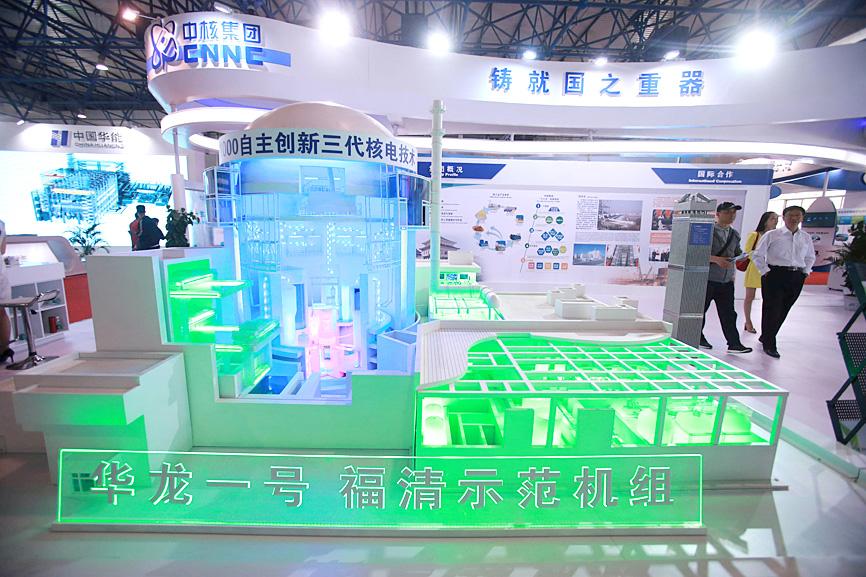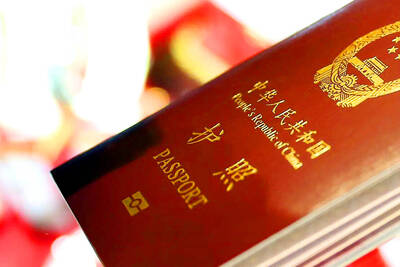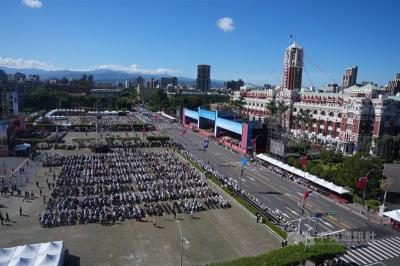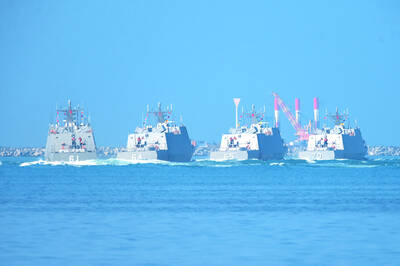China has powered up its first domestically developed nuclear reactor — the Hualong One — a significant step in Beijing’s attempts to become less dependent on Western allies for energy security and critical technology.
The reactor, which was on Friday connected to the national grid, can generate 10 billion kilowatt-hours of electricity per year and cut carbon emissions by 8.16 million tonnes, the China National Nuclear Corp (CNNC, 中國核工企業集團) said.
“This marks China breaking the monopoly of foreign nuclear power technology and officially entering the technology’s first batch of advanced countries,” CNNC said in a statement.

Photo: Reuters
Nuclear plants supplied less than 5 percent of China’s annual electricity needs last year, the Chinese National Energy Administration said, but this share is expected to grow as Beijing attempts to become carbon neutral by 2060.
Reducing its dependence on Western allies in critical high-tech sectors such as power generation is a key goal in Beijing’s “Made in China 2025” plan.
Billions of dollars in state subsidies have been given to Chinese companies to speed the process — a move that has angered China’s trade partners and sparked a protracted trade row with Washington.
Work on the Hualong One reactor started in 2015 and there are six other reactors under construction at home and abroad, state-owned plant operator CNNC said.
Hualong One, deployed at a plant in Fuqing in China’s Fujian Province about 200km from Taipei, would be put into commercial use by the end of the year after undergoing tests.
China has 47 nuclear plants with a total generation capacity of 48.75 million kilowatts — the world’s third highest after the US and France.
Beijing has invested billions of dollars to develop its nuclear energy sector in the past few years as it struggles to wean its economy from coal.
Thirteen nuclear plants are under construction, more than in any other country, despite environmental and safety concerns.
In August 2016, officials were forced to shelve plans for a nuclear waste facility in Lianyungang, a city in Jiangsu Province, after a rare public protest by thousands of residents.
Additional reporting by staff writer

The Ministry of the Interior (MOI) is to tighten rules for candidates running for public office, requiring them to declare that they do not hold a Chinese household registration or passport, and that they possess no other foreign citizenship. The requirement was set out in a draft amendment to the Enforcement Rules of the Public Officials Election and Recall Act (公職人員選舉罷免法 ) released by the ministry on Thursday. Under the proposal, candidates would need to make the declaration when submitting their registration forms, which would be published in the official election bulletin. The move follows the removal of several elected officials who were

The Republic of China (ROC) is celebrating its 114th Double Ten National Day today, featuring military parades and a variety of performances and speeches in front of the Presidential Office in Taipei. The Taiwan Taiko Association opened the celebrations with a 100-drummer performance, including young percussionists. As per tradition, an air force Mirage 2000 fighter jet flew over the Presidential Office as a part of the performance. The Honor Guards of the ROC and its marching band also heralded in a military parade. Students from Taichung's Shin Min High School then followed with a colorful performance using floral imagery to represent Taiwan's alternate name

FOUR DESIGNATED AREAS: Notices were issued for live-fire exercises in waters south and northwest of Penghu, northeast of Keelung and west of Kaohsiung, they said The military is planning three major annual exercises across the army, navy and air force this month, with the navy’s “Hai Chiang” (海強, “Sea Strong”) drills running from today through Thursday, the Ministry of National Defense said yesterday. The Hai Chiang exercise, which is to take place in waters surrounding Taiwan, would feature P-3C Orion maritime patrol aircraft and S-70C anti-submarine helicopters, the ministry said, adding that the drills aim to bolster the nation’s offshore defensive capabilities. China has intensified military and psychological pressure against Taiwan, repeatedly sending warplanes and vessels into areas near the nation’s air defense identification zone and across

A Chinese takeover of Taiwan would severely threaten the national security of the US, Japan, the Philippines and other nations, while global economic losses could reach US$10 trillion, National Security Council Deputy Secretary-General Lin Fei-fan (林飛帆) wrote in an article published yesterday in Foreign Affairs. “The future of Taiwan is not merely a regional concern; it is a test of whether the international order can withstand the pressure of authoritarian expansionism,” Lin wrote in the article titled “Taiwan’s Plan for Peace Through Strength — How Investments in Resilience Can Deter Beijing.” Chinese President Xi Jinping’s (習近平) intent to take Taiwan by force